古民家オーナーインタビューvol.1
児童文化の殿堂「絵本と木のおもちゃ 横田や」
Edifice for Children’s Culture “Yokotaya – Picture Books and Wooden Toys”
English here.
「古民家びと企画」の古民家オーナーインタビュー第1弾は、仙台市青葉区にある「絵本と木のおもちゃ 横田や」のオーナー、横田重俊さん。築140年以上と言われるお店に入ると、所狭しと並べられた木のおもちゃが目に飛び込んできます。奥には絵本コーナーがあり、お店全体におとぎの世界のような独特の時間が流れていて、また来てみたくなるお店です。
味噌しょうゆのお店「横田屋」から「絵本と木のおもちゃ 横田や」へ
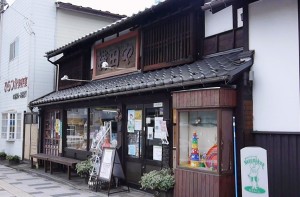
「横田や」の「や」は、もともとは漢字でした。味噌しょうゆのお店「横田屋」の住居兼お店で、工場が裏にあって、明治から昭和までは工場で醸造してお店で売るというスタイルでした。今残っているのは、お店部分だけです。
祖父は、ここで暮らしていました。2階に職人さんが何人か住んでいて、その奥には大祖母が暮らしていて、ここでみんな暮らしていました。
祖父がお店を辞めた後、店舗を文房具屋さんに10年ほどお貸しして、その文房具屋さんが辞めた後を引き継いだというのが「横田や」の始まりです。文房具屋さんをやりながら、好きだった絵本を横に置いたので、最初は、「文房具と絵本」のお店でした。
絵本のお店としては、漢字は合わないから平仮名に変えました。「横田屋」より「横田や」の方が良いじゃない?!昔のお店には、今のような大きな看板はなく、小さな板の看板でした。
絵本との出会い、おもちゃとの出会い
大学院の時、谷川俊太郎さんの「ことばあそびうた」をラジオで聴いて、それを探したら絵本だった。絵本って面白いメディアだと思いました。
おもちゃは、宮城県の美術館でヨーロッパのおもちゃ展をやっていて、そこで出会いました。その後、どんどん文房具はなくなって、今は片隅に残っている程度。おもちゃは絵本と近いところにある、という気がしたのです。だんだん「絵本とおもちゃ」になったんです。
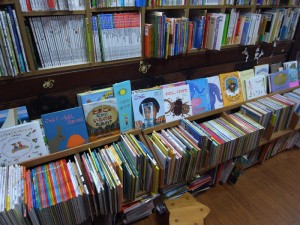
世の中で売れないものを売る空間
木のおもちゃは高くて売れないから置いていないお店も多いけれど、ここでは普通のおもちゃ屋さんでは売っていないおもちゃを売っています。絵本もこれだけの数は売れないとよく言われます。世の中で売れないものを売っています。子供は自分でお財布を持っていないから、お客さんは子供連れの大人です。
この商売をやっていて、この建物に助けられているというのはあります。来てくださる方に、合っていると言われたり、東京にあったら大変なことになるよと言われたり。マッチした空間になってくれているのだと思います。
建て替えようと思ったことは?

建て替えるとお金がかかりますからね。それなりの歴史がある建物だろうから。内装をやってくれた大工さんが、色々教えてくれて面白かったです。ここはこういう造りをしているよ、解体する時は釘が高価だから拾いなよ、あのケヤキの1枚戸も持っていかれないようにね・・・などなど。
引き出しに明治9年に定吉さんがつくったと書いてあって、そこまでは遡ることができました。この建物自体がどうなのかは分からないけれど、おそらく同じ頃につくられたのでしょう。
この辺りは、昭和30年代までは古い建物が当たり前に残っていました。立派な土蔵などもあったのですが、道路計画に引っかかって、壊されてしまいました。
「紙芝居」は、日本独自の児童文化
紙芝居は、英語でも「カミシバイ」。日本にしかない独自のものです。児童文化財です。「ペーパーシアター」とかではないんですよ(笑)。絵本をつくるとなると、印刷して製本してと大変だけど、さほどの施設がなくても文化を子供達に伝えられる点で紙芝居は良いんです。
宮城県の図書館には、昔の紙芝居が沢山あって、国の指定文化財にもなっています。仙台に最後に残った紙芝居屋さんが寄贈されたそうです。
元々は化学をやろうとしていたから、子供のことは勉強していませんでした。「読み聞かせ」というのも知りませんでした。自分でやるようになって、今は児童文化という分野で、保育所や幼稚園の先生に、なぜやるのか、どうやるのかを教えています。
絵本とおもちゃは、子供と大人をつなぐコミュニケーションツール
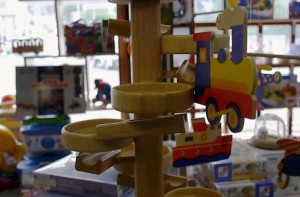 絵本やおもちゃは、子供と大人をつなぐコミュニケーションツールである、と言い続けてきました。いい時間、いい関係を過ごせるもの、僕らはそういうものを扱ってきました。
絵本やおもちゃは、子供と大人をつなぐコミュニケーションツールである、と言い続けてきました。いい時間、いい関係を過ごせるもの、僕らはそういうものを扱ってきました。
道具だから使い方を間違うと怖いですよ。「知育教材」と言われるとあまり好きじゃないですね。「知育玩具」ならまだいいけれど、「教材」と言われると逆転しちゃう。大人は目標を設定して、そこに行かせようとするけれど、それは違うと思う。やらせられて身につくものではなく、やりたくて身につくものだと思います。
東日本大震災の時
地震の時は、お店にいました。よくみると壁にすきまがあいたりしていますが、基本的な構造には問題がなかった。(行政の行っている)耐震診断では完全にダメと言われていたけれど、持ちこたえてくれて有難うございました、という気持ちです。ギシギシとすごい音で家がきしむのを体験しました。前の瓦だったら完全に落ちていたと思うけれど、10数年前に新しいタイプの瓦に替えていたのも良かったですね。
この地震で多くの古い家がなくなってしまって・・・。古民家だけじゃなく、地震で残ったものを大事にして欲しいですね。
震災後のボランティア活動について
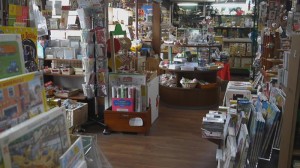 宮城県の子供達を日常に戻してあげたい。33年間、この商売をやってきたお礼をしたいという思いから、「こどもとあゆむネットワーク」の活動を始めました。そして3年しか活動しないと宣言しました。3年で目途が立って欲しいという願いも込めて区切りを設けました。3年経ってもある程度戻っていなかったら、僕ら大人が悪い。
宮城県の子供達を日常に戻してあげたい。33年間、この商売をやってきたお礼をしたいという思いから、「こどもとあゆむネットワーク」の活動を始めました。そして3年しか活動しないと宣言しました。3年で目途が立って欲しいという願いも込めて区切りを設けました。3年経ってもある程度戻っていなかったら、僕ら大人が悪い。
邪魔にならず、ごみにもならない、アメリカ製の強化ダンボールでつくった本棚も製作しました。
絵本と木のおもちゃ 横田や http://www.yokotaya.net/
こどもとあゆむネットワーク http://www.ayumunet.jp/
横田重俊さん
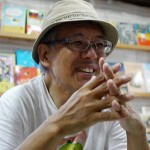
「絵本と木のおもちゃ 横田や」オーナーさんオススメのスポットはこちら!
より大きな地図で 絵本と木のおもちゃ横田や を表示 |
この地図の周辺スポットを見る 仙台広瀬河畔教会納骨記念碑 象設計集団による手描きのタイル絵やモニュメントがある。 所在:宮城県仙台市青葉区北山1-17 北山キリスト教墓地内maruhocafeマルホカフェ 通称おもちカフェ。お餅を使ったメニューが美味。 所在:宮城県仙台市青葉区北山1丁目2-24Cake里菜 住宅街の中にあり、普通は見つからない。 所在:宮城県仙台市青葉区山手町5-16 |
ENGLISH
Cominka Owner Interview vol.1
Edifice for Children’s Culture “Yokotaya – Picture Books and Wooden Toys
As the second edition of Cominka People Opening Special Feature “Cominka Owner Interviews”, we would like to deliver you the interview of Shigetoshi Yokota, who is the owner of toy & book shop “Yokotoaya” in Aoba ward, Sendai. As you enter the shop, which is said to be more than 140 years old, you are overwhelmed by wooden toys which fill up the space. The next room is for picture books, and the whole shop is like a wonderland – somewhere that makes you come back again.
From “miso and soy source” to “picture books and wooden toys”
“Ya” of “Yokotaya” used to be in Chinese character. This place was both home and shop for “Yokotaya – miso and soy source”. There was a factory behind this building, and they would produce their product there then sell it here. It’s only this shop structure that’s remaining. My grandfather lived here, there were some miso and soy source makers living on the second floor, behind their rooms lived my great grandmother… everybody was living together here. After my grandfather closed the shop, we leased this place to a stationary shop for about 10 years, then when the stationary shop was closing down, I took it over. That’s how Yokotaya started. I started to sell picture books which I really like, so at the beginning it was “stationary and picture books”. And as a picture book shop I thought Hiragana was more appropriate than Chinese character, so I changed the name a little bit. We didn’t have a large name board as we do now. We had only a small wood plate.
Encountering picture books and toys
When I was doing my MA, I heard “Wordplay Song” by Shuntaro Tanikawa from radio by chance. Then as I looked for it, it was actually a picture book. That’s when I found out that picture book is a very interesting medium. As for toys, I encountered its charm at the European Toy Exhibition in Miyagi Museum of Art. After that, we started to shift away from stationary – it’s occupying only a small corner now. I felt toys are somewhere very close to picture book. So we gradually became “picture book and toys” as we are now.
We sell things that are not selling in other places
Many toy shops don’t deal with wooden toys as they are expensive and don’t sell. But we deal with those toys that other shops don’t. Picture books, too – I’m often told we have too many in the shop. We are just selling stuff that other people don’t. It’s not children that actually pay for toys and picture books, so our customers are adults with children. It is true that doing my trade, this building has helped me. Customers often say things like “it’s a good match”, “It’s something you can’t have in Tokyo”… I guess this cominka is providing a good space.
Have you ever thought of rebuilding?
It costs a lot, you know. And surely it’s a building with some history. A carpenter who did the interior told me many interesting things about this building “this part has some characteristic structure”, “if you ever deconstruct, nails are very expensive so make sure to keep them”, “Make sure to keep that zelkova plate, too” etc. On one of built-in drawers says it was built by somebody called Jokichi in 1876. That’s how far we can go back. We don’t know the exact year in which it was built, but I presume around that time. In this area, great old buildings were abundant up to around 1950s – there were buildings like large kura (Japanese warehouse), but they were demolished in redevelopment.
Kamishibai – a unique Japanese children’s culture
Kamishibai just made it into English as it is. It’s unique to Japan. It’s Children’s Cultural Property. It’s not “Paper Theater” (literal translation of Kamishibai)! If you want to publish a picture book, it requires lots of time and process like printing, bookbinding, etc. Kamishibai is good at this point; you can convey culture with children with minimum of equipment. Libraries of Miyagi have many old Kamishibai; they are Designated National Cultural Property. I heard the last Kamishibai performer in Sendai donated them. I originally wanted to become a chemist, so I didn’t know anything about children. I didn’t know what “reading session” was. Having started myself long time ago, I now teach it to kindergarten staff why we need it and how to do it, as a part of the field called Children’s Culture.
Picture book and toy are communication tool that connect children and adults
For a long time, I have said picture books and toys are communication tools that connect children and adults. Something with which you can have a good time, good relationship with children – that’s what we have been dealing with. As they are tools, scary things can happen when you use them in a wrong way. I don’t like the word “educational material”. “Educational toy” is a little bit better, but as soon as you start using the word “material”, it’s like a means becoming and end. Adults set the goal and make children go there, but I thing that’s wrong. It’s not like you learn because you are told to do it – you learn because you want to do it.
When the Great East Japan Earthquake happened
I was at this shop. If you look closely, there are some cracks, but no problem on the basic structure of this building. I’m really grateful to the building for enduring, all the more because it didn’t pass the earthquake resistance test. During the tremor I was hearing huge creaking sound. I’m sure all roof tiles would have fallen, if we hadn’t renewed them a few years ago. Many old houses were lost by the earthquake… I hope everything, not only cominka, that survived the earthquake will be treated well.
On his volunteer activities after 3.11
Having felt urge to help children regain everyday life and as a token of my gratitude for keeping me in this business for 33 years, I launched “Walking with Children Network”, declaring it will operate no longer than 3 years. It signifies my hope that before 3 years pass, we will have concrete idea of how to rebuild. If not, it’s all we adults’ fault. Our activities include providing bookshelves made of reinforced cardboards, which neither take up space nor become garbage.
Shigetoshi Yokota
Born in Sendai, Yokota lived in Yamagata until he was 3, then in Tokyo up to his 20s. Originally pursuing to become a chemist, after acquiring a MA in chemistry he returned to Sendai, where he took over a stationary shop, shortly starting to sell picture books as well. “Yokotaya – Picture Books and Wooden Toys” is in its 33rd year now. As a preacher of children’s culture, he has been teaching at universities and organizing many reading sessions at kindergartens. After March 11th, in order to “help children get back to everyday life as soon as possible”, he has been tirelessly visiting kindergartens and schools of affected areas, delivering picture books, toys, stationaries and “playing”. He is the representative and a co-founder of “Walking with Children Network”, which has so far delivered more than 40,000 picture books to the affected areas.
Yokotoya – Picture Books and Wooden Toys
http://www.yokotaya.net/
Walking with Children Network
http://www.ayumunet.jp/
Discover the area with places the owner of “Yokotaya – Picture Books and Wooden Toys” recommends!


